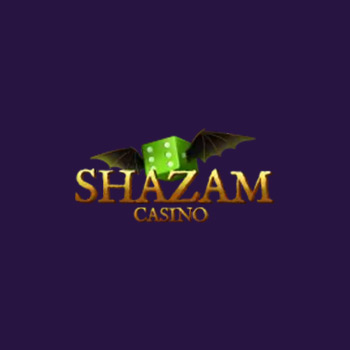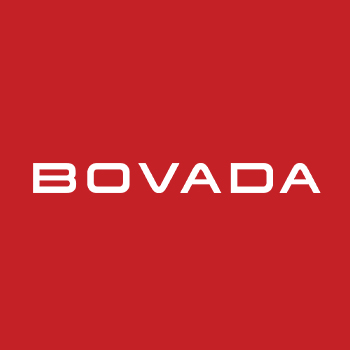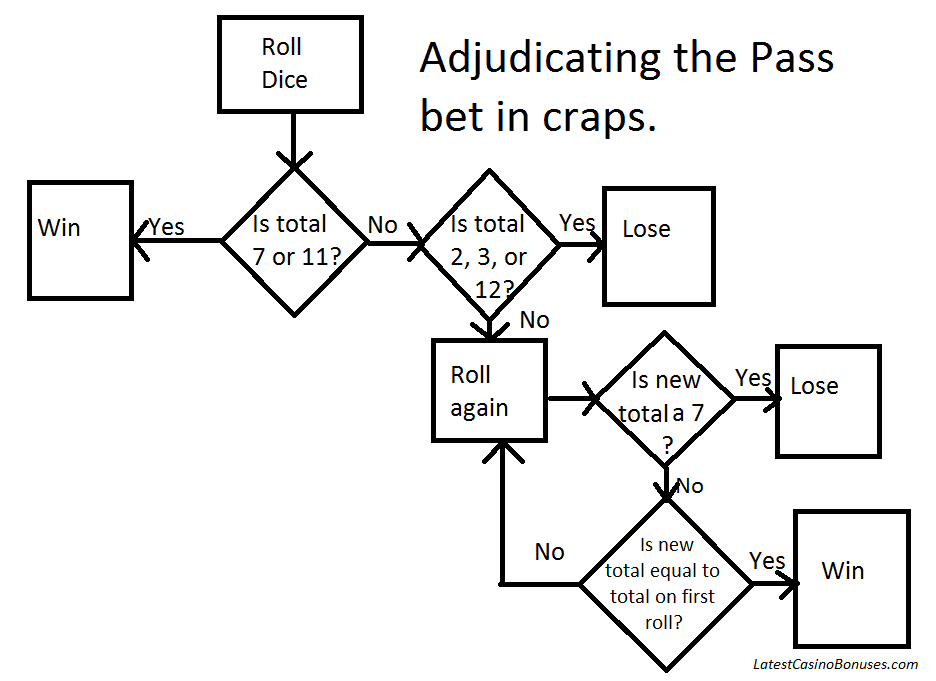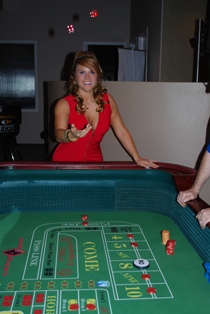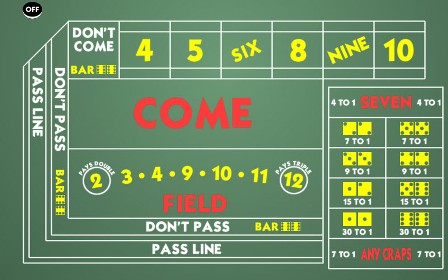On this page
Craps
Introduction
Craps can be an intimidating game for the beginner. The table seems to have about a hundred different kinds of bets, the players are barking out commands in what seems to be a foreign language, and the pace is too fast to ever ask a question. I can sympathize with the beginner, because at one point in time this was how craps appeared to me.
If this is how you view the game, I have good news. There is one fundamental bet, the "pass line" bet, that almost all players make. You can easily get by knowing just this bet your first time. As you get more experienced, you can add more bets to your repertoire. After just your first five minutes, you should feel comfortable with the flow of the game and can start acting natural, like you've been a craps player for years.
 Top Craps Online Casinos
Top Craps Online Casinos
Defining the House Edge
Craps has a lot of different kinds of bets. Some always resolve in one roll and others may take many rolls. The standard definition of the house edge is the ratio of the expected player loss to the initial wager. Almost every legitimate gambling writer counts pushes in this calculation. However, in craps it often takes many rolls to resolve a bet, with the player being allowed to take down the bet at any time until it wins or loses.
Should such meaningless rolls, that don't effect the outcome, be treated as the wager pushing? Compared to other casino games, that would be the consistent thing to do. However, craps players usually leave such bets up until they are resolved. The question gambling writers must face is whether to count meaningless rolls as a push in calculating the house edge, or wait until the wager is resolved. After much thought, I have decided to express the house edge in craps three ways:
- Per bet made (counting pushes).
- Per bet resolved (not counting pushes).
- Per roll (house edge per bet resolved divided by average number of rolls).
If your reason for knowing the house edge is a measure of how good of a bet it is and/or the value at generating comps, then you should go by the "per roll" figure. In all forms of gambling I try to teach the player to make the best bets. In my opinion, the best bets in craps are those with a low "per roll" house edge.
Pass
The Pass is the most fundamental bet in craps; almost every player at the table bets on it. If you only understand one bet in craps, it should be this one.
The Pass bet is put on the the pass line itself on a come out roll. You can tell it is a come out roll if there is a black laminated marker on the table that says "off." If the come out roll is a 7 or 11, then you win even money. If the come out roll is a 2, 3, or 12, then you lose. If any other total is rolled (4, 5, 6, 8, 9, or 10) that total is called "the point." The dealer will turn over the marker that says "off" to the white "on" side, and place it on an area of the table with that number, to help the players remember what the point is. Then, the shooter will roll the dice until he either rolls that same point again, or a seven. If a seven comes before the point, then you lose. If the point is rolled first, then you win even money.
Do not make a Pass bet after the come out roll. This is allowed but is highly ill-advised because the value of a pass line bet is diminished after the come out roll.
Here is a flow chart (I made myself) showing how to adjudicate a pass bet.
Pass
| Per | House Edge |
|---|---|
| Bet made | 1.41% |
| Bet resolved | 1.41% |
| Roll | 0.42% |
The Odds
The Odds is like a side bet in craps made after a point is thrown. It pays if the point is thrown before a seven. The odds on the Odds are exactly fair, which zero house edge. To be specific, the Odds pays 2 to 1 on points of 4 and 10, 3 to 2 on a 5 and 9, and 6 to 5 on a 6 and 8. To make an odds bet after a pass line bet just put the odds bet behind the pass line bet, outside of the pass line area on the side closer to you.
Taking the Odds
| Per | House Edge |
|---|---|
| Bet made | 0.00% |
| Bet resolved | 0.00% |
| Roll | 0.00% |
Because the Odds has zero house edge the player can only bet so much on it compared to his Pass bet. Most casinos allow what is known as "3- 4-5X Odds." This means the player may bet up to three times his Pass bet on the odds after a point of a 4 or 10, four times after a 5 or 9, and five times after a 6 or 8. How did they come up with this? I think because if the player always takes the maximum odds, and he wins on the pass line, the Odds bet will always pay 6 times the pass line wager, making the math easier for the dealers.
Some casinos pay even more, like 5X, 10X, 20X, or 100X odds on all points. If you see a casino advertising something like "10X Odds," that means that you can bet up to ten times you Pass bet on the Odds.
Finally, if comps are important to you, then be warned that most casinos do not count bets on the Odds towards the average amount you bet, because they don't stand to make any profit on it.
Don't Pass
The don't pass is almost the opposite of the pass line bet. If the come out roll is a 2 or 3 then you win, a 7 or 11 you lose. A 12 is a push, except in Reno and Lake Tahoe, where a 2 is a push instead of the 12. Otherwise, the dice are rolled over and over until either the point or a 7 is rolled. If the 7 comes first you win, if the point come first you lose. All wins pay even money.
A person betting on the don't pass is called a "wrong" bettor and is usually winning when everone else is losing, and vise versa. If you make this bet, keep a low profile. The other players do not want to see you yelling "yippy" as they are losing.
Don't Pass
| Per | House Edge |
|---|---|
| Bet made | 1.36% |
| Bet resolved | 1.40% |
| Roll | 0.40% |
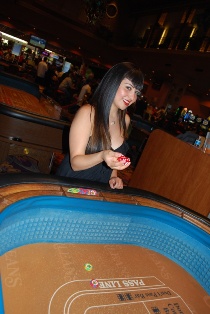 |
Laying the Odds
This is the opposite of taking odds, in other words betting that a seven will be rolled before the point. It is called Taking the Odds if you bet on a point after a Pass bet. It is called Laying Odds if you bet against a point after a Don't Pass bet. In both cases the odds are statistically fair, with no house edge. To be specific Laying the Odds against a 4 or 10 pays 1 to 2, against a 5 or 9 pays 2 to 3, and against a 6 or 8 pays 5 to 6.
Much like Taking Odds, the amount you may take Laying Odds is limited to some multiple of your Don't Pass bet. For example, if casino allows 5X Odds, then you may bet up to an amount such that a win would be no more than 5X the Don't Pass bet. In the case of the common 3-4- 5X Odds, you can Lay up to 6X the Don't Pass bet after any Point, which would result in a win of 3, 4 or 5X the Don't Pass bet.
Laying the Odds
| Per | House Edge |
|---|---|
| Bet made | 0.00% |
| Bet resolved | 0.00% |
| Roll | 0.00% |
Come, Don't Come
A Come bet is mathematically the same as a Pass bet. The only difference is it is made any time other than a Come Out roll. The following roll after a Come bet will act as a Come Out Roll for purposes of the Come bet. Like Pass bets, you may take Odds after a Come bet. Wins and the multiple you may take on the Odds is the same for both Pass and Come bets.
Likewise, a Don't Come bet is like a Don't Pass bet, except made anytime except a Come Out roll. You may also lay the Odds if any point is rolled after a Don't Come bet, in the same way as a Don't Pass bet.
Place
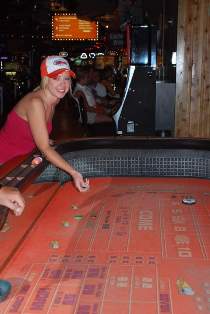 |
In craps the 4,5,6,8,9, and 10 are known as the Place numbers. The player may bet on any of these numbers, and if it is rolled before a seven, the bet wins. Place bets are just like odds bets, except no pass line bet is required, and don't pay as much odds. To be specific, place bets on the 6 and 8 pay 7 to 6, the 5 and 9 pay 7 to 5, and the 4 and 10 pay 9 to 5. The tables below show the best odds are on the 6 and 8.
Place 6 and 8
| Per | House Edge |
|---|---|
| Bet made | 0.46% |
| Bet resolved | 1.52% |
| Roll | 0.46% |
Place 5 and 9
| Per | House Edge |
|---|---|
| Bet made | 1.11% |
| Bet resolved | 4.00% |
| Roll | 1.11% |
Place 4 and 10
| Per | House Edge |
|---|---|
| Bet made | 1.67% |
| Bet resolved | 6.67% |
| Roll | 1.67% |
Place to Lose
Place to Lose bets to lose are the opposite of Place bets. They win on a seven, and lose on the the number you're betting against. As far as I know, Place to Lose bets are found only in Australia, England, and some Internet casinos. The odds paid are as follows.
- 6 and 8: 4 to 5
- 5 and 9: 5 to 8
- 4 and 10: 5 to 11
The following tables show the house edge of Place to Lose bets.
Place to Lose — 6 and 8
| Per | House Edge |
|---|---|
| Bet made | 0.56% |
| Bet resolved | 1.82% |
| Roll | 0.56% |
Place to Lose — 5 and 9
| Per | House Edge |
|---|---|
| Bet made | 0.69% |
| Bet resolved | 2.50% |
| Roll | 0.69% |
Place to Lose — 4 and 10
| Per | House Edge |
|---|---|
| Bet made | 0.76% |
| Bet resolved | 3.03% |
| Roll | 0.76% |
Buy
Buy bets are like Odds or Place bets, except with different odds. The concept is that they pay fair odds, like Odds bets, except you have to pay a 5% commission to make the bet, based on the bet amount. This commission is usually non-refundable. However, at some casinos, the commission on the 4 and 10 is charged only on a win. The following tables show the house edge both with the commission always payable and after a win only.
Buy — 6 and 8
| Per | Commission Paid | |
|---|---|---|
| Always | Win Only | |
| Bet made | 1.46% | 0.69% |
| Bet resolved | 4.76% | 2.27% |
| Roll | 1.46% | 0.69% |
Buy — 5 and 9
| Per | Commission Paid | |
|---|---|---|
| Always | Win Only | |
| Bet made | 1.32% | 0.56% |
| Bet resolved | 4.76% | 2.00% |
| Roll | 1.32% | 0.56% |
Buy — 4 and 10
| Per | Commission Paid | |
|---|---|---|
| Always | Win Only | |
| Bet made | 1.19% | 0.42% |
| Bet resolved | 4.76% | 1.67% |
| Roll | 1.19% | 0.42% |
As mentioned above, Place and Buy bets are exactly the same thing, but with different odds. Here is the better bet, according to the number bet on:
- 6 and 8: Place bet always better.
- 5 and 9: Place bet always better, unless commission on Buy is on win only.
- 4 and 10: Buy bet always better.
Hot Tip: The Santa Ana Star casino in New Mexico allows buy bets on the 4 and 10 with no commission, resulting in zero house edge. For that, I salute them!
Lay
Lay bets are like laying the Odds or Place to Lose bets, except with different odds. The concept is that they pay fair odds, like Odds bets, except you have to pay a 5% commission to make the bet, based on the win amount. This commission is usually non-refundable. However, at some casinos, the commission on the 4 and 10 is charged only on a win. The following tables show the house edge both with the commission always payable and after a win only.
Lay — 6 and 8
| Per | Commission Paid | |
|---|---|---|
| Always | Win Only | |
| Bet made | 1.22% | 0.69% |
| Bet resolved | 4.00% | 2.27% |
| Roll | 1.22% | 0.69% |
Lay — 5 and 9
| Per | Commission Paid | |
|---|---|---|
| Always | Win Only | |
| Bet made | 0.90% | 0.56% |
| Bet resolved | 3.23% | 2.00% |
| Roll | 0.90% | 0.56% |
Lay — 4 and 10
| Per | Commission Paid | |
|---|---|---|
| Always | Win Only | |
| Bet made | 0.61% | 0.42% |
| Bet resolved | 2.44% | 1.67% |
| Roll | 0.61% | 0.42% |
As mentioned above, Place to Lose and Lay bets are exactly the same thing, but with different odds. Here is the better bet, according to the number bet on:
- 6 and 8: Place to Lose bet always better.
- 5 and 9: Place to Lose bet always better, unless commission on Lay is on win only.
- 4 and 10: Lay bet always better.
Big 6 and 8
The Big 6 and 8 are exactly like the place bets on 6 and 8, respectively, except pay even money, instead of 7 to 6. You would be a fool to make these bets with you could get much better odds on the same thing with a Place bet.
Big 6 and 8
| Per | House Edge |
|---|---|
| Bet made | 2.78% |
| Bet resolved | 9.09% |
| Roll | 2.78% |
Hard Ways
Rolling an even number with the same number of both dice is said to be the "hard way." The "easy way" is rolling an even number with different numbers on the dice. For example, a hard 8 would be a 4-4, while an easy 8 would be 2-6 or 3-5.
There are four Hard Way bets, on the 4, 6, 8, and 10. Each wins by rolling the specified number the hard way, and lose on any 7 or on an easy way. For example, the hard 8 would win on 4&4 and lose on any total of 7, 2-6, or 3-5. Following is a flow chart showing how to adjudicate the Hard 8 bet, as an example.
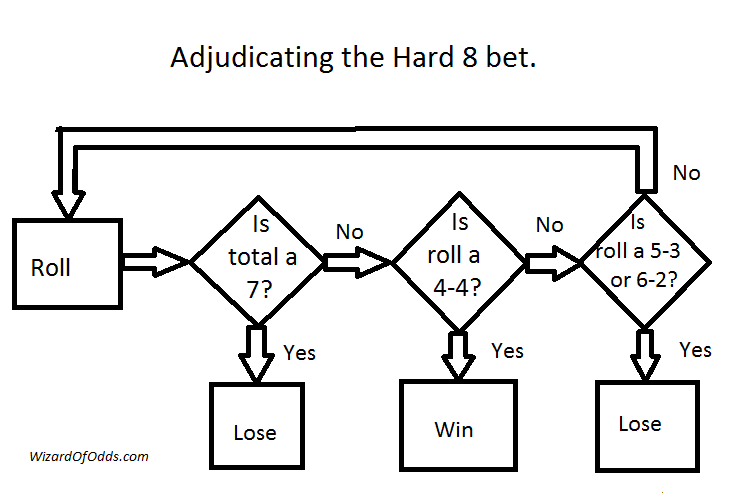
These bets are long shots so pay higher odds than everything we've seen so far. In the U.S., and most other countries, the Hard 6 and 8 pays 9 to 1, and the Hard 4 and 10 pays 7 to 1. In Australia, they add 0.5 to all Hard Way wins, for 9.5 on the 6 and 8, and 7.5 on the 4 and 10. Bravo Australia!
Hard — 6 and 8
| Per | Rules | |
|---|---|---|
| U.S. | Australia | |
| Bet made | 2.78% | 1.39% |
| Bet resolved | 9.09% | 4.55% |
| Roll | 2.78% | 1.39% |
Hard — 4 and 10
| Per | Rules | |
|---|---|---|
| U.S. | Australia | |
| Bet made | 2.78% | 1.39% |
| Bet resolved | 11.11% | 5.56% |
| Roll | 2.78% | 1.39% |
Put Bets
In craps, the player may skip the come out roll on a pass or come bet. Such a late bet on the pass and come is known as a "put bet." Much of the value in pass and come bets is in the come out roll, so skipping it carries a high house edge. To be specific, 33.33% on the 4 and 10, 20.00% on the 5 and 9, and 9.09% on the 6 and 8, on a per bet resolved basis. However, you can combine a put bet with an odds bet, bringing down the overall house edge. Here are the breakeven points, according to point.
- 6 and 8: Bettor must combine a put bet with 5X odds to have the same overall house edge of 1.52% as a place bet.
- 5 and 9: Bettor must combine a put bet with 4X odds to have the same overall house edge of 4.00% as a place bet.
- 4 and 10: Bettor must combine a put bet with 19X odds to have the same overall house edge of 1.67% as a buy bet, assuming the commission is paid on a win only. If the commission is always paid then the bettor must combine a put with with 6X odds to match the 4.76% house edge.
Turning Bets On and Off
Many bets can be removed, or temporarily turned off, at any time. Namely all Odds bets, Place, Place to Lose, Buy, Lay, and Hard Ways bets. While these bets can be temporarily turned off for a roll, some of them automatically are on a come out roll, unless otherwise requested. Here are the rules of what is on and off on a come out roll.
- Odds on Come bets: OFF
- Place bets: OFF
- Buy bets: OFF
- Odds on Don't Come bets: ON
- Place to lose bets: ON (These bets are found in Australia, so I'm not 100% sure on this one)
- Lay: ON
- Hard Ways: ON in Las Vegas and OFF in Atlantic City.
Summary of Multi-Roll Bets
The following table summarizes all the bets that may take more than one roll to resolve.
Multi-Roll Bets in Craps
| Bet | Pays | Prob. Win |
Prob. Push |
Prob. Loss |
Avg. Rolls |
House Edge per | ||
|---|---|---|---|---|---|---|---|---|
| Bet Made |
Bet Resolved |
Roll | ||||||
| Pass | 1 to 1 | 49.29% | 0.00% | 50.71% | 3.38 | 1.41% | 1.41% | 0.42% |
| Don't Pass | 1 to 1 | 47.93% | 2.78% | 49.29% | 3.47 | 1.36% | 1.40% | 0.40% |
| Taking Odds 6 and 8 | 6 to 5 | 13.89% | 69.44% | 16.67% | 3.27 | 0.00% | 0.00% | 0.00% |
| Taking Odds 5 and 9 | 3 to 2 | 11.11% | 72.22% | 16.67% | 3.60 | 0.00% | 0.00% | 0.00% |
| Taking Odds 4 and 10 | 2 to 1 | 8.33% | 75.00% | 16.67% | 4.00 | 0.00% | 0.00% | 0.00% |
| Laying Odds 6 and 8 | 5 to 6 | 16.67% | 69.44% | 13.89% | 3.27 | 0.00% | 0.00% | 0.00% |
| Laying Odds 5 and 9 | 2 to 3 | 16.67% | 72.22% | 11.11% | 3.60 | 0.00% | 0.00% | 0.00% |
| Laying Odds 4 and 10 | 1 to 2 | 16.67% | 75.00% | 8.33% | 4.00 | 0.00% | 0.00% | 0.00% |
| Place 6 and 8 | 7 to 6 | 13.89% | 69.44% | 16.67% | 3.27 | 0.46% | 1.52% | 0.46% |
| Place 5 and 9 | 7 to 5 | 11.11% | 72.22% | 16.67% | 3.60 | 1.11% | 4.00% | 1.11% |
| Place 4 and 10 | 9 to 5 | 8.33% | 75.00% | 16.67% | 4.00 | 1.67% | 6.67% | 1.67% |
| Don't Place 6 and 8 | 4 to 5 | 16.67% | 69.44% | 13.89% | 3.27 | 0.56% | 1.82% | 0.56% |
| Don't Place 5 and 9 | 5 to 8 | 16.67% | 72.22% | 11.11% | 3.60 | 0.69% | 2.50% | 0.69% |
| Don't Place 4 and 10 | 5 to 11 | 16.67% | 75.00% | 8.33% | 4.00 | 0.76% | 3.03% | 0.76% |
| Buy 6 and 8 * | 23 to 21 | 13.89% | 69.44% | 16.67% | 3.27 | 1.46% | 4.76% | 1.46% |
| Buy 5 and 9 * | 29 to 21 | 11.11% | 72.22% | 16.67% | 3.60 | 1.32% | 4.76% | 1.32% |
| Buy 4 and 10 * | 39 to 21 | 8.33% | 75.00% | 16.67% | 4.00 | 1.19% | 4.76% | 1.19% |
| Buy 6 and 8 ** | 23 to 20 | 13.89% | 69.44% | 16.67% | 3.27 | 0.69% | 2.27% | 0.69% |
| Buy 5 and 9 ** | 29 to 20 | 11.11% | 72.22% | 16.67% | 3.60 | 0.56% | 2.00% | 0.56% |
| Buy 4 and 10 ** | 39 to 20 | 8.33% | 75.00% | 16.67% | 4.00 | 0.42% | 1.67% | 0.42% |
| Lay 6 and 8 * | 19 to 25 | 16.67% | 69.44% | 13.89% | 3.27 | 1.22% | 4.00% | 1.22% |
| Lay 5 and 9 * | 19 to 31 | 16.67% | 72.22% | 11.11% | 3.60 | 0.90% | 3.23% | 0.90% |
| Lay 4 and 10 * | 19 to 41 | 16.67% | 75.00% | 8.33% | 4.00 | 0.61% | 2.44% | 0.61% |
| Lay 6 and 8 ** | 19 to 24 | 16.67% | 69.44% | 13.89% | 3.27 | 0.69% | 2.27% | 0.69% |
| Lay 5 and 9 ** | 19 to 30 | 16.67% | 72.22% | 11.11% | 3.60 | 0.56% | 2.00% | 0.56% |
| Lay 4 and 10 ** | 19 to 40 | 16.67% | 75.00% | 8.33% | 4.00 | 0.42% | 1.67% | 0.42% |
| Hard 6 and 8 (US) | 9 to 1 | 2.78% | 69.44% | 27.78% | 3.27 | 2.78% | 9.09% | 2.78% |
| Hard 6 and 8 (AU) | 19 to 2 | 2.78% | 69.44% | 27.78% | 3.60 | 1.39% | 4.55% | 1.26% |
| Hard 4 and 10 (US) | 7 to 1 | 2.78% | 75.00% | 22.22% | 3.27 | 2.78% | 11.11% | 3.40% |
| Hard 4 and 10 (AU) | 15 to 2 | 2.78% | 75.00% | 22.22% | 3.60 | 1.39% | 5.56% | 1.54% |
* Commission always paid
** Commission paid on win only
The Proposition Bets
Proposition bets either win or lose on the next throw. In general these have the highest house edge of all the crap bets and players with any sense at all will avoid them completely. The following table shows the various prop bets available. Different wins are known to exist on the prop bets. In the U.S., usually the payoff odds are the lower ones. The casinos in the U.K. and Australia are known to have the more liberal rules.
Since all Proposition Bets resolve in one throw and never push the house edge is the same whether defined as per made, resolved, or per throw.
Proposition Bets
| Bet | Pays | Ways to Win | Ways to Lose | Prob. Win | House Edge |
|---|---|---|---|---|---|
| 2, 12, and all "hard" hop bets | 33 to 1 | 1 | 35 | 2.78% | 5.56% |
| 2, 12, and all "hard" hop bets | 32 to 1 | 1 | 35 | 2.78% | 8.33% |
| 2, 12, and all "hard" hop bets | 31 to 1 | 1 | 35 | 2.78% | 11.11% |
| 2, 12, and all "hard" hop bets | 30 to 1 | 1 | 35 | 2.78% | 13.89% |
| 2, 12, and all "hard" hop bets | 29 to 1 | 1 | 35 | 2.78% | 16.67% |
| 3, 11, and all "easy" hop bets | 16 to 1 | 2 | 34 | 5.56% | 5.56% |
| 3, 11, and all "easy" hop bets | 15 to 1 | 2 | 34 | 5.56% | 11.11% |
| 3, 11, and all "easy" hop bets | 14 to 1 | 2 | 34 | 5.56% | 16.67% |
| Any craps (2, 3, or 12) | 7 to 1 | 4 | 32 | 11.11% | 11.11% |
| Any craps (2, 3, or 12) | 7.5 to 1 | 4 | 32 | 11.11% | 5.56% |
| Any seven | 4 to 1 | 6 | 30 | 16.67% | 16.67% |
There are various ways of making combinations of prop bets. One common one is the "horn" bet, which is divided equally between the 2, 3, 11, and 12. Sometimes a player will make "horn high" bet, which doubles the bet on one of those numbers. Another common bet is the "world" which is five equal bets on the 2, 3, 7, 11, and 12.
Hot Tip: If you must bet on a 7, don't make the any 7 bet, with a house edge of 16.67%. Instead, divide your bet by 3, and put 1/3 each on the 1-6, 2-5, and 3-4 hop bets. Even at the stingy payoff of 15 to 1, you will still lower the house edge to 11.11%.
Field Bet
The field is a one time bet that the next roll will be a 2, 3, 4, 9, 10, 11, or 12. All wins pay 1 to 1, except the 2 and 12 pay more. In Las Vegas most casinos pay 2 to 1 on the 2, and 3 to 1 on the 12. In Reno, they switch them, paying 3 to 1 on the 2, and 2 to 1 on the 12. The following table shows the possible outcomes. The lower right cell shows a house edge of 2.78%.
Field Bet — 2 or 12 pay 3-1
| Number | Pays | Combinations | Probability | Return |
|---|---|---|---|---|
| 2 | 2 | 1 | 0.027778 | 0.055556 |
| 12 | 3 | 1 | 0.027778 | 0.083333 |
| 3, 4, 9, 10, 11 | 1 | 14 | 0.388889 | 0.388889 |
| 5, 6, 7, 8 | -1 | 20 | 0.555556 | -0.555556 |
| Total | 36 | 1 | -0.027778 |
Some stingy casinos, namely the Harrah's corporate properties, the Riviera, and the Casino Royale, pay only 2 to 1 on both the 2 and 12. This doubles the house edge to 5.56%. The Santa Ana Star casino in New Mexico pays 3 to 1 on both the 2 and 12, for exactly zero house edge. Bravo!
Strategy
Optimal strategy in craps is pretty simple. Bet the don't pass and/or don't come and back it up laying the maximum odds. That is known as "playing the dark side," because the vast majority of players bet the opposite way. If you don't want to be a contrarian, and enjoy going with the flow, then the pass and/or come bets, plus taking full odds, is almost as good.
The following table shows the combined house edge on the pass or come bet, backed up by taking full odds according to the maximum odds allowed. "Full double odds" is 2X odds on all points except the 6 and 8, in which case it is 2.5X. "3X-4X-5X" means the maximum odds are 3X on the 4 and 10, 4X on the 5 and 9, and 5X on the 6 and 8.
Combined House Edge on Pass/Come & Taking Full Odds
| Odds | House Edge Per | ||
|---|---|---|---|
| Bet Made |
Bet Resolved |
Roll | |
| 1X | 0.00848 | 0.00848 | 0.00251 |
| 2X | 0.00606 | 0.00606 | 0.00180 |
| Full double | 0.00572 | 0.00572 | 0.00169 |
| 3X | 0.00471 | 0.00471 | 0.00140 |
| 3X-4X-5X | 0.00374 | 0.00374 | 0.00111 |
| 5X | 0.00326 | 0.00326 | 0.00097 |
| 10X | 0.00184 | 0.00184 | 0.00055 |
| 20X | 0.00099 | 0.00099 | 0.00029 |
| 100X | 0.00021 | 0.00021 | 0.00006 |
The next table shows the combined house edge on the don't pass or don't come, backed up by laying the full odds. The house edges in the don't table below are significantly less than the do table above. For example, with 3X-4X-5X odds the combined house edge on the pass is 0.374%, while on the don't pass is 0.273%. I think that makes the don't pass look deceptively significantly better. The main reason it is less is the odds multiple is relative to your bet taking odds, and the win when laying odds.
Although the player may bet more laying the odds, the variance is still the same. For example, if the point is a 4, and the table allows 3X odds, the variance is the same betting $30 with a 1/3 chance to win $60, or $60 with a 2/3 chance to win $30. So, don't bet the don't side because you may lay more on the odds. In my opinion, the only advantage to the don't side is the 0.05% lower house edge on the don't pass or don't come bet. If the pass side is more fun, go ahead and bet that way; I won't shake my finger if I catch you at the table.
Combined House edge on Don't Pass/Come & Taking Full Odds
| Odds | House Edge per | ||
|---|---|---|---|
| Bet Made |
Bet Resolved |
Roll | |
| 1X | 0.00682 | 0.00701 | 0.00202 |
| 2X | 0.00455 | 0.00468 | 0.00135 |
| Full double | 0.00431 | 0.00443 | 0.00128 |
| 3X | 0.00341 | 0.00351 | 0.00101 |
| 3X-4X-5X | 0.00273 | 0.00281 | 0.00081 |
| 5X | 0.00227 | 0.00234 | 0.00067 |
| 10X | 0.00124 | 0.00128 | 0.00037 |
| 20X | 0.00065 | 0.00067 | 0.00019 |
| 100X | 0.00014 | 0.00014 | 0.00004 |
Miscellaneous Comments and Advice
- The players take turns throwing the dice. In general the same person will throw until they seven out. The player may pass the dice if they want to.
- Know the rules and what to do before you arrive at the table, especially a busy one. Try not to rely on the dealers for answering questions.
- Craps has a language all its own. It is beyond the scope of this page to define all the terminology but you can pick it up as you go. For example, "Two way yo" is crap slang for a bet on 11 in which half is for the player and half is a bet for the dealers.
- When you throw the dice they are supposed to rebound off the other side of the table. Some players like a high lob, and others let the dice roll down the table. Personally, I prefer the lob.
- Don't put drinks on the table. There is a little shelf under the chips for glasses and bottles.
- Don't sit or lean on anything.
- Don't listen to the advice of the other players, especially those betting anything in the middle of the table.
- As in all games you should tip the dealers, especially if they are being especially helpful. When you tip, don't make a bet for the dealers on a sucker bet as most players do. I like to just give the dealers a tip directly after a good run, by saying "for the table."
- Blend in with, but do not interact with, the other players. Never say the word "seven," except on a come out roll, because it is considered bad luck by many. I know it is irrational and superstitious, but why draw attention to yourself by saying it?
- If you are playing for the first time don't announce this if you are male. Male virgins to the game are said to be unlucky, and the opposite for females. This is evidently because virginity is despised in men and valued in women.
Online Craps Casino Bonuses
Play for Free
I'm very proud of my play for free craps games. Just click on the image below to try your luck.


